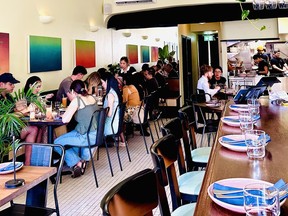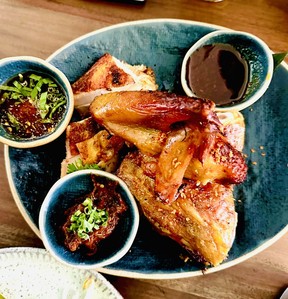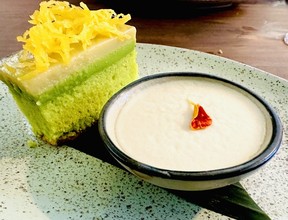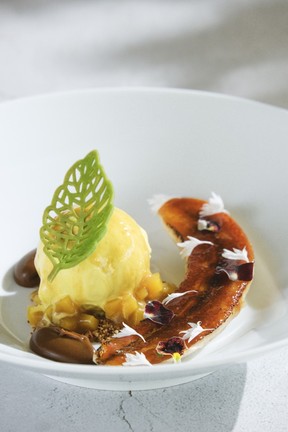Restaurant review: Honest, authentic Isaan cuisine lands on Vancouver's Davie Street
The owner of the Michelin-recommended Maenam Thai restaurant has opened another Thai spot in Vancouver. Here's our review.

Article content
Reviews and recommendations are unbiased and products are independently selected. Postmedia may earn an affiliate commission from purchases made through links on this page.
Sainam
Where: 1235 Davie St., Vancouver
When: Lunch and dinner, Thursday to Saturday; dinner, Sunday to Wednesday
Info: 604-880-6989 | sainam.ca
At Sainam, there’s no dumbing down. At Angus An’s seventh restaurant, you get the real deal — authentic, unedited food from the Isaan region in northeast Thailand. “It’s the poorest region and the food is a lot more honest, robust, and rustic,” says owner and chef An. “First and foremost, I love the food of that region. It’s right up my alley, food that’s grilled, fried, fermented.”
When I reached An by phone, he and his business partner/wife Kate Auewattanakorn were in Toronto, in a sad-happy time of setting up their son, Aidan, for his first year of university. The couple had just recently opened Sainam on Davie Street, adding to their Full House Hospitality restaurant group (Michelin-recommended Maenam, Longtail Kitchen, two branches of Fat Mao, Sen Pad Thai) and partnerships at Popina (Granville Island) and Mekong (Whistler).
Sainam means creek or little water in Thai while Maenam, the name of their flagship restaurant, means river or mother water — fitting, as their son starts his own journey. Sainam, the restaurant, adheres to one region more than any of their other restaurants and An developed the dishes with the chef de cuisine, Poom Sikarin Sirisupanon, who is from Isaan.
Zingy papaya salad (som tum) is beloved in Isaan. “I’ve seen menus devote two full pages to it,” says An. “It’s very, very well received there. Most people think it’s the same everywhere but there are regional differences and spinoffs.”
The vibrant, lively dish, with shredded unripe papaya and sour, spicy, salty, sweet flavours (lime juice, chili, garlic, fish sauce, palm sugar) originated in the neighbouring country of Laos as their national dish. The green unripened papayas are a skinnier, longer variety than the ones with a paunch. To prepare the papaya, An first cuts it then gives it a light bruising with in a wooden mortar and pestle to release more flavour.
His papaya salads don’t occupy two menu pages (the entire Sainam menu is but a page) but he does offer seven of them ($16 to $17). There’s the classic with peanuts and dried shrimp; Laotian style with salt-cured crabs and fermented fish sauce; another with fermented rice noodles and pork sausage; spicy Korat style with fermented fish paste and long beans; another features grilled sweet corn, peanuts and dried shrimp; and a fried papaya salad that includes papaya fritters.
I ordered the som tum Luang Prabang since I once spent a magical week in this World Heritage Site city, arriving on the Mekong River on a loud diesel-powered boat with an Italian professional clown on board (long story short, very interesting). For the Luang Prabang salad, the papaya is cut into a wide pappardelle noodle shape and the flavours are bold and funky and refreshing ($17) with satisfying crunch. But as much as I love pappardelle pasta, I decided when it comes to green papaya salad, I like a finer cut.
One area where An eases up on authenticity is on heat level — Thai people are insulated from, or love, chili on fire. I know that I once burst into flames upon eating a street vendor’s papaya salad in Bangkok. Searing heat, seared in memory. It would be cruel to serve that to unsuspecting Vancouver diners. “We cut down on the spiciness,” An says. “It’s not what it’s like in Thailand, but I still think it’s spicy.”
Funky flavoured dishes with ingredients such as preserved crab and fermented anchovy sauce sell well, he tells me, indicative of expanding local palates. “They’re my favourite. Our servers read the customers and guide them but now people are willing to try.”
The Wichian Buri Grilled Chicken ($32) exemplifies Isaan’s love of charcoal grilled meats, although in the Sainam kitchen, it’s not grilled with charcoal. “Kate and I love it. When we’re in Thailand (at a family property), we have it all the time. I tried to figure out the marinade over a Christmas holiday in Thailand and made this instead of turkey.”

The dish features a half locally grown Loong Kong chicken with skin so crispy, it merits an ASMR video upon cutting into it. “It’s because of how we dry it,” says An. “It’s air-dried after butchering.” The tasty, bronzed bird comes with three sauces — tamarind, chili, and sweet chili.
A herb salad with spice-braised beef tendon, beef shin, grilled steak and tripe ($23) offers an easy initiation for the tripe-adverse — the small pieces are tender and hardly noticeable. There are, however, sharp darts of heat in the dish that lightly stab the tongue.
I haven’t tried it yet but the Isaan sausage ($14) has interesting sour notes from fermented cooked rice that encourages lactic acid bacteria, lowering the pH of the pork. “It’s one of my favourite things in Thailand,” says An. “It goes with beer so easily.”
Korat pad mee, a stir-fried noodle dish with crispy pork jowl ($25), is unlike the familiar sweet, hot and sour pad Thai that we all know and love. This slopes into sour and some funk and the sauce is a little slipperier.
For dessert ($10), it’s a duo: kanom tuay, a custard in a saucer made with coconut, rice flour and palm sugar, and a spongy cake with layers of pandan custard and coconut custard.

Spicy foods need an easygoing coolant and nothing’s more chill than beer. There’s lots on offer here, whether it’s from Southeast Asia or east Vancouver. Don’t miss An’s collab with Main Street Brewing, a crispy lager with black lime, created to match the chef’s cuisine. Wines are chosen to complement the spicy dishes as much as wine can, such as Rieslings, bubblies, rosés, and Pinot noirs. All are reasonably priced ($48 to $78 by the bottle) and available by the glass. The short cocktail list (all $18) includes drinks with pandan- and chili-infused gins, lychee juice, cashew nuts, housemate tamarind sauce and finger root, a southeast Asian ginger.
Side dishes
With Vancouver’s incredible range of Asian restaurants, it’s puzzling there’s not much Indonesian food out there. Three homesick Indonesians are about to change that, at least for one night.
RASA (flavour) is a one-night-only dinner featuring unique interpretations of six of Indonesia’s most famous dishes plus amuse-bouches and palate cleanser. It takes its name from the Indonesian verb that means to taste, touch, think and feel.

The event is a collaboration with Kley Klemens, of the popular blog and Instagram account Jewkarta, Patrick Gani, of the Indonesian coffee shop Blaze Café, and Akira Takaki, a sous chef at the Michelin-recommended, pan-Asian restaurant, Torafuku. Takaki, who was born and raised in Bali and graduated from a culinary institute there, developed the menu for RASA by combining Indonesia’s bold flavours with classical French cooking techniques. Expect elevated versions of beef rendang, mie goreng and other traditional dishes.
RASA takes place on Sept. 30 at Torafuku (958 Main St.). There are two seatings, at 5 and 8 p.m. Each seating has a limited capacity of 36. Tickets are $120 per person, available from ubud.ca/rasa.
miastainsby@gmail.com
x.com/miastainsby
instagram.com/miastainsby
vancouversun.com/tag/word-of-mouth-blog














Postmedia is committed to maintaining a lively but civil forum for discussion. Please keep comments relevant and respectful. Comments may take up to an hour to appear on the site. You will receive an email if there is a reply to your comment, an update to a thread you follow or if a user you follow comments. Visit our Community Guidelines for more information.